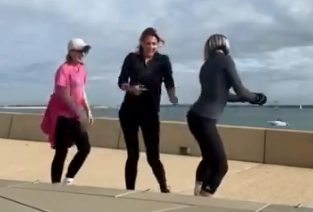Feeling overwhelmed? Dancing for stress relief is one of the fastest, most enjoyable ways to calm your mind and reconnect with your body. Just a few minutes of movement can help shift your mood, release tension, and bring you back to the present—no dance experience needed.
This is a perfect example of how dancing and Stress Relief can boost your mood. We have some women in our outdoor fitness group who, when that certain 4-to-the-floor beat hits just right, will break out into a couple of spontaneous dance moves. Happens all the time when I turn to look at my workout notes!
It gives us all a lift — even if we are the shy ones. And if we catch it on a Reel, it lifts people who weren’t even there. Besides, it makes us look cool as a club.
🔊 Music Makes You Move
The music we use in our workouts is carefully chosen — that certain 4-to-the-floor or double beat that almost forces you to move. It’s not your average ‘80s Spotify playlist. More like the kick-ass tunes that play during the end of action movies.
If I hear one of those tracks, I nab it and add it to our playlist. Each song is paired with what we’re doing, so moving to the beat helps you forget how hard you’re working because you’re focused on the music.
I listen to music all the time — planning workouts in my head even when I’m doing other things. Since discovering how much fascia loves movement, I’ve started breaking out into a couple of moves myself during meal prep. You know, bottle of wine, music on, hands are busy — would be rude not to get my feet involved.
Instant feelgood. Dance those cares out the door. Why haven’t I done this before?
The bigger benefit is stress relief — tiny moments of spontaneous dancing for stress relief resets your mood and help loosen your body. Your fascia is a very real part of your make-up. It needs some love too! Your body holds memories of movement and emotion—dancing can help unlock them!
I see this often in our sessions outdoors — real, embodied stress relief through movement in Southsea Portsmouth, not performance.
🧠 The Science Behind Spontaneous Dancing for Stress Relief
How does dancing reduce stress?
Studies show that spontaneous dancing can lower cortisol (the stress hormone) and boost dopamine and serotonin — chemicals that help us feel good and reduce anxiety.*
It’s movement for nervous system regulation, but it doesn’t look like therapy!
Breaking out into a couple of moves helps you relieve stress naturally and quickly.
Movement also stimulates fascia, which benefits from varied, fluid motion. Healthy fascia reduces physical tension and helps your body feel more comfortable.
There’s more: dancing for stress relief improves joint mobility and coordination, and may help protect long-term cognitive health by increasing blood flow and brain connectivity.
🎵 What Music Does to Help Relieve Stress and Boost Your Mood
Music has a powerful effect on us, including:
- Your brain likes patterns — it knows what is coming next, so it can chill out. Music is patterns!
- Music increases dopamine for that feelgood rush
- Music lowers cortisol, reducing stress
- Music synchronises brain waves to improve focus and relaxation
- Music encourages movement and coordination
- Music elevates mood and motivation
That 4-to-the-floor beat we use? It’s wired to make you want to move.
So next time you feel overwhelmed, remember that just a few minutes of moving to music can be all you need to feel how dancing can relieve stress.
🌿 Coming Soon: More on Dancing for Stress Relief, Nature, Barefoot Movement, and Mental Wellbeing
If you read our Instagram captions, you’ll see we often say our focus isn’t just fitness. Because of our privileged location next to the ocean — with ships passing, birds, dogs being walked — plus the music and a small group that knows each other well and chats, mental wellbeing is an important side benefit.
You can Comment or ask questions on this post in Instagram.
We would love to hear from you!
🧾 Citations
On dance and stress/mood:
- Quiroga Murcia, J. A., Kreutz, G., Clift, S., & Bongard, S. (2010). Dance and health: Exploring interactions between dance and wellbeing. Arts & Health, 2(2), 149–163.> Dance and health: exploring how dancing supports wellbeing
- Kattenstroth, J. C. et al. (2013). Six months of dance intervention enhances postural, sensorimotor, and cognitive performance in elderly without affecting cardio-respiratory functions. Frontiers in Aging Neuroscience, 5, 5.> Six months of dance improves sensorimotor and cognitive performance
On music and brain/body:
- Thoma, M. V. et al. (2013). The effect of music on the human stress response. PLOS ONE, 8(8), e70156> The effect of music on the human stress response
- Chanda, M. L., & Levitin, D. J. (2013). The neurochemistry of music. Trends in Cognitive Sciences, 17(4), 179–193. >The neurochemistry of music: how songs change our brain > The neurochemistry of music: how songs change our brain
Want to explore more about how fascia influences movement, mood, and memory?
Visit our fascia-informed movement and emotional wellbeing homepage to dive deeper into the science and practice.

